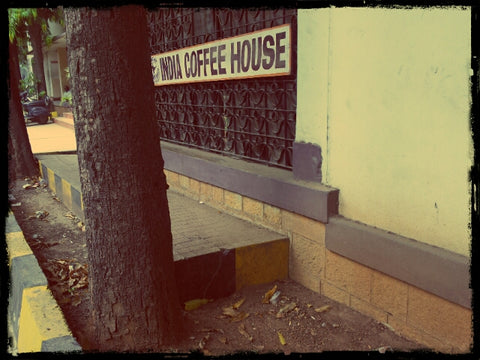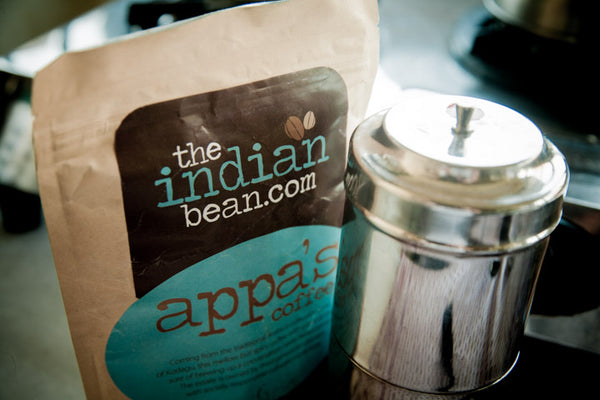There is a comic description of how they sell coffee in south India:
The vendor holds a jug high up in one hand with the cup down below in the other – a distance of over three. He pours the coffee into the cup, then back into the jug, then back into the cup - a couple of times of this back and froth, before he offers it to his customer.
Thus, in south India, coffee is sold by the meter.
It is claimed the coffee is also aerated this way. Scientifically accurate - with the coffee falling like a waterfall into the cup, tiny air bubbles are formed in the brew.
All in all, a curious and delightful experience, if you’re seeing it for the first time.
Traditionally, this is how coffee was served in south India. And the froth was perhaps copied later by vending machines.
Coffee is to south India like beer is to Germany. The rich aroma as ubiquitous as its availability.
There was a time it was sold in small earthen pots. Now stainless steel has replaced the pots, and it often comes to you in a peculiar fashion - two utensils, one conical flat-bottom cup upturned into a flat, rounded bowl, the two held together by a vacuum. To get the coffee, you have to pull out the cup so the coffee empties into the bowl.
There are stalls that also serve you the instant variety – powder sprinkled on the top of a sweetened milky froth, but that is a poor cousin of true coffee made from ground beans. And a coffee lover will justifiably disdain it.
If you’re in the Nilgiris on a cold morning, nothing is equivalent to this cup; and if the Blue Mountain Express from Mettupalayam is chugging up, the white smoke from that train and the fumes from the decoction pot are so similar, one reminds you of the other.
HISTORY – even that is a conversation piece.
Just as the word coffee has come from several origins – the English chaoua, the Ottoman Turkish kahve, the Italian caffè, the Arabic qahwah and qahā – coffee itself comes from several countries, being cultivated in over 70.
And if you took the most miles covered by any single item, it’s probably coffee - exported all around the globe. The crop cannot grow outside the tropical belt – between the Tropics of Cancer and Capricorn - but it is enjoyed, piping hot, on a climb up the Himalayas or on an expedition to the Antarctica.
And in at least one country – Cuba – it is responsible for breeding slavery. Between 1511 and 1886 over one million slaves were imported from Africa to Cuba in order to cultivate the crop.
Coffee is a well-known conversation starter, so fittingly, the brew itself starts the debate and dispute about its origins. Today, drinkers and researchers have agreed to conclude that it originated somewhere in Arabia, more accurately in Yemen or Ethiopia. Perhaps true, because only Arabs can drink that strong brew without the aid of milk or sugar.
They’ve also agreed that, taken in small quantities, it is an excellent stimulant. More thoughts and ideas came out of Europe around the time it was introduced there. Historically not proven, but then, with coffee nothing is supposed to be proven.
Social scientists, though, are not clear why coffee stimulates conversations, but possibly while you’re waiting for it to cool down to sipping and savouring temperature, you have nothing else to do but talk about the weather or your wedding plans. Who’s ever heard of an embarrassing silence over coffee?
Seven is a sacred number
Coffee did not come to India in the most legitimate of marketing and distribution plans – it was smuggled into India in 1670. Story has it that a Sufi saint and traveler, Baba Buden, while returning from a pilgrimage to Mecca, strapped seven coffee seeds to his chest and travelled to India with them, and the first plants from these seeds were grown in Mysore.
“And why seven seeds?” you may ask. Seven is a sacred number in Islam.
But beginning in the 1400s until modern times, men were more busy finding sources and routes to trade in coffee, than to chat over a cup. The bean has seen some furious marketing warfare - some religions banned it, others encouraged it, thus causing plentiful ups and downs in its acceptability and availability. In wars, defeated armies were usually searched for any supplies of coffee.
You can control the bean not the aroma
The seven beans brought back to India by Baba Buden were planted in the Chandragiri Hills in the Chikkmaglur district of Karnataka.
Then a certain Britisher, Mr Kent, with a nose for coffee aroma and money, saw these trees and started growing them around Mysore. Hence one of the grades of Indian Coffee is Kent AA, which is the Arabica variety. From here, coffee soon spread to neighbouring Kerala and Tamil Nadu. And under the British colonial management, a flourishing trade soon started with exports to Europe and the Americas.
Interestingly, in the era prior to the free markets of 1991 in India, coffee was a controlled item. From sowing to transporting every coffee activity was under supervision of the Coffee Control Board. What could not be controlled, however, was the taste for the brew in south India, and from here onwards, the whole of India.
If you pass by a shop that grinds coffee beans, the aroma is strangely irresistible. Traditionally, people bought the beans and then got it ground, to ensure the rich, pure stuff.
The first taste of coffee - India Coffee House



If you been around any of the major cities in India you would have noticed an outlet named “India Coffee House.” This chain of was first started by the British in 1940. By 1957, it was taken over by Indian management and the first outlet came up in Bangalore on MG Road. Gradually the chain spread to several parts of India, where many an Indian, outside south India, had his first taste of the brew.
Connoisseurs will agree, this is the finest coffee ever. You can smell the beans being ground in your cup. So strong is the attraction for decoction coffee that marketers have packaged and sold it all over India with huge success.
A smaller version of this apparatus is sold in markets in south India which people use to brew their coffee at home.
And mind you, the chain ‘India Coffee House’ predates Starbucks by like 50 years or so. Indians, with time on their hands and gossip on their minds, the chain was bound to spread.
How grandmother made coffee
A relatively unknown ingredient was first used to make coffee in south India – jaggery, or gur in Hindi. Sugar wasn’t used as the sweetener.
In a pot gone black with soot from years of resting on a stove every morning, grandmother would boil water with jaggery in it. When the jaggery melted, she would add the coffee powder – the beans she herself had ground earlier in the market – and boil the whole concoction for some twenty minutes. Then she’d allow the coffee dregs to settle at the bottom of the pot. Then she’d strain the coffee, leaving the dregs behind, and the family’s cup of morning coffee was ready.
This writer’s parents, who lived in Coonoor, Nilgiris, one of the coffee growing areas in Tamil Nadu, brewed coffee in exactly the same way.

More than a culture, a cult
In south India, two people standing by to have a chat must have a cup of coffee each to complete the chat.
If you stop by somebody’s home, you’ll be served a cup of steaming hot coffee. And usually your visit may last as long as it takes you to finish the coffee. There are homes in south India where you will see a kettle of coffee throughout the day. They just heat it, and continue sipping.
Like elders in rural India who gather over the hookah, now in every part of India people gather over a cup of coffee.
People get selected for jobs over coffee, girls and boys meet for the first time, people read a book over coffee or ideate a plot for a book, or plan a business takeover, or an enterprise…
Anything can happen over coffee.
